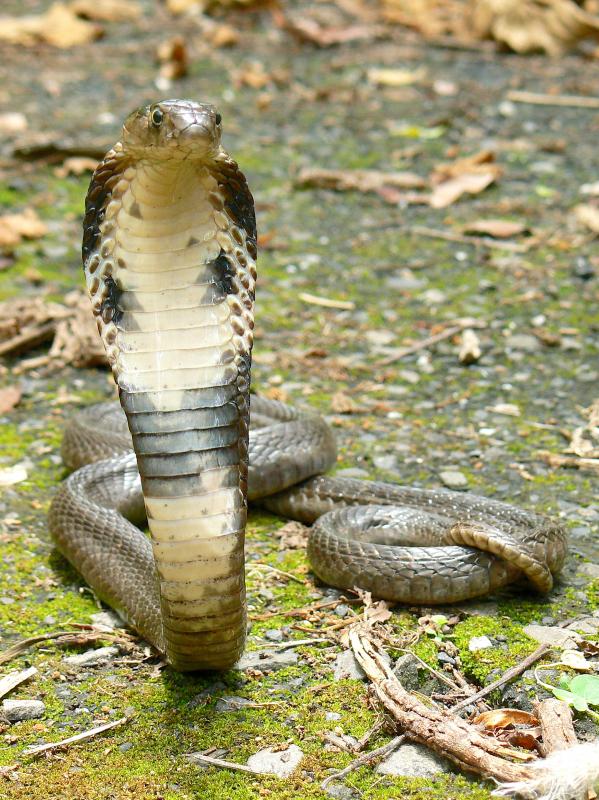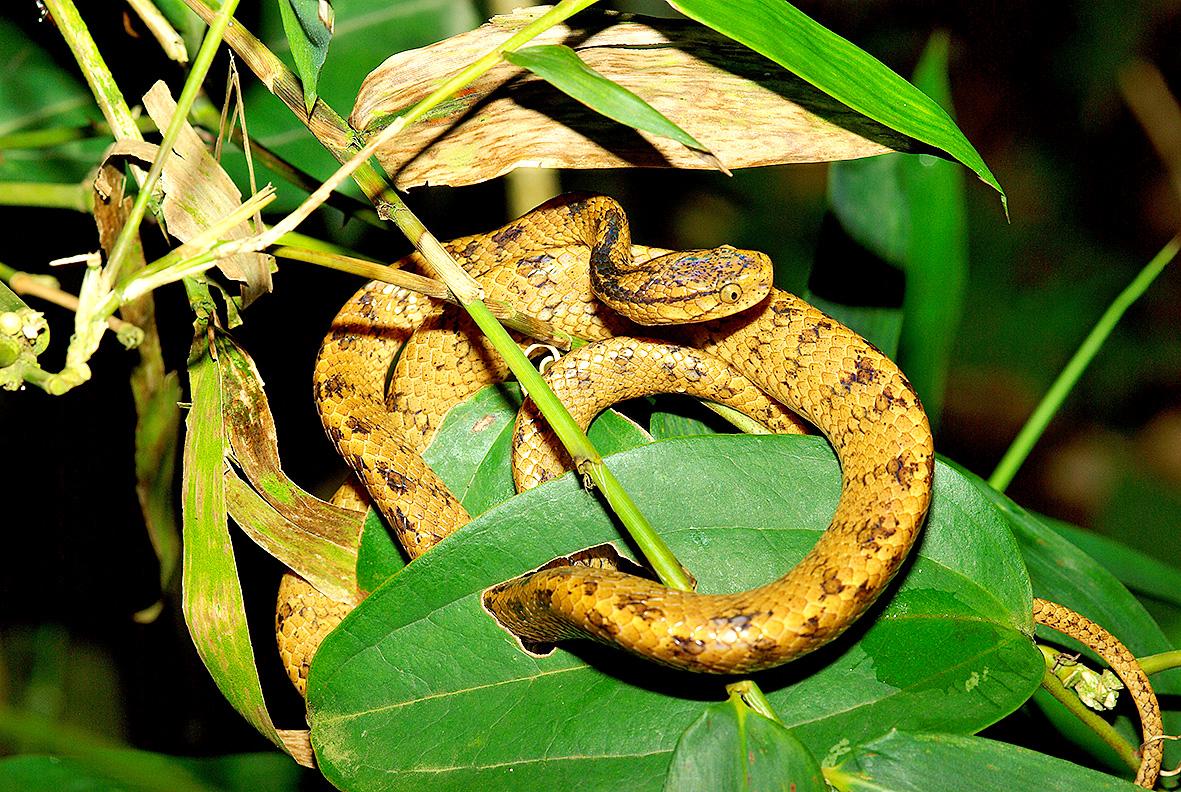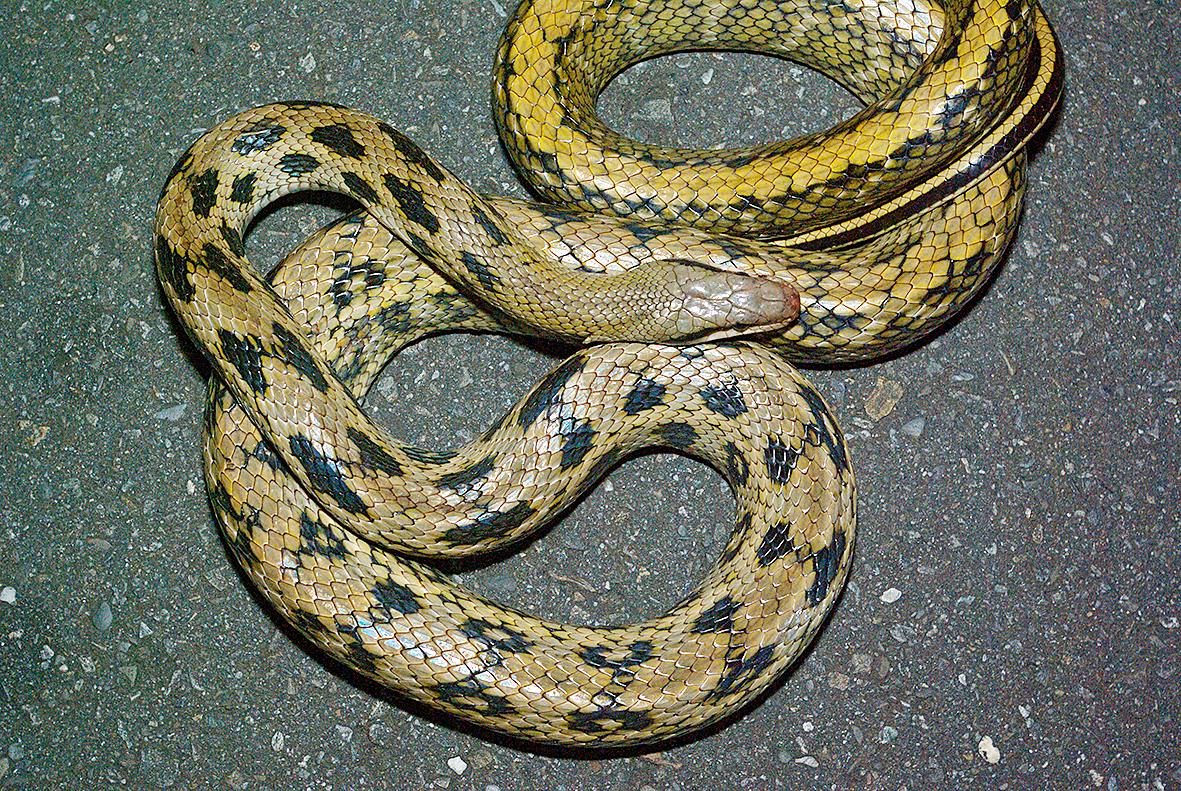Last November, visitors to Taroko National Park (太魯閣國家公園) were warned not to leave any car windows open near the Baiyang Trail (白楊步道), after several tourists reported seeing Formosan rock macaques break into vehicles and search for food. Around the same time, another macaque troop got a reputation for grabbing snacks from sightseers’ hands at the park’s Tiansiang Service Station (天祥遊客服務站).
Such occurrences are exceptional, however. In Taiwan, the wildlife-human interface is far more often traumatic for the former than for the latter.
Hunting is still common in Aboriginal areas. The country’s tremendous population density and rapid development since World War II have pushed some species to extinction. Yet, if you know where and when to look and what to look for, wild creatures aren’t difficult to find.

Photo courtesy of Gerrut Norval
On mountain roads and hiking trails, I’ve encountered crab-eating mongooses, Formosan sambars, Reeves’s muntjacs, Taiwan serows, countless macaques and snakes, along with birds that don’t exist in other countries — all in broad daylight. In wooded areas after dark, I’ve glimpsed masked palm civets, yet more serpents, and, just once, a red-giant flying squirrel.
“Feral cats and dogs aren’t wildlife, because those species have already been domesticated. Exotic pets that escape from human control but which aren’t native species aren’t wildlife. They should be considered exotic species. But wild animals illegally taken as pets are still wildlife,” explains Philip Liao (廖朝盛), an animal keeper at WildOne Wildlife Rescue Center in Taitung County’s Chihshang Township (池上).
“We want people to keep their distance from and not bother wild animals, but at the same time we hope they can express genuine concern for wildlife,” says Liao.

Photo courtesy of Hans Breuer
During his childhood in Germany, Hans Breuer was fascinated by snakes. The obsession eventually gave way to other interests, then returned full-throttle when the translator was in his early 40s, married and settled in New Taipei City’s Sanjhih District (三芝).
In his book A Cobra Hijacked My Camera Bag! Snakes and Stories from Taiwan, Breuer — who’s lived in Taiwan for 24 out of the past 32 years — describes the central part of the North Cross-Island Highway (北橫公路) as “hands down the best road-cruising blacktop in all of Taiwan” for herping (searching for amphibians or reptiles).
Around 40 of the island’s 53 snake species can be found close to the road, “where the northernmost reach of many species overlaps the southernmost reach of others.”

Photos courtesy of Hans Breuer
In the south, Breuer writes, the herping season runs pretty much all year round. The north shuts down between January and March.
Of the 53, Breuer has encountered all but five or six in the wild.
“However, I’ve never seen a hundred-pacer, even though it’s such an iconic creature,” he says, referring to the venomous snake known to scientists as Deinagkistrodon acutus, and venerated by some of Taiwan’s indigenous tribes.

Photo: Steven Crook
Asked to name his favorite herp, he nominates the Chinese cobra (Naja atra): “It’s perfectly proportioned. Few people know that the pose for which it’s famous — rearing up and hissing — actually signifies defeat. It means the cobra is too exhausted to flee. It’s a last resort when cornered.”
Hardcore herpers prefer two wheels to four, because it’s easier to look down into a roadside ditch from a scooter than it is from a car. The decaying leaf litter in these gutters attracts insects, and these bugs in turn attract the amphibians and lizards, which snakes feed on.
For a while, Breuer logged every single snake sighting on a form that eventually included 28 data fields, such as time of day, weather and the creature’s behavior.
“I used to be one of those guys who always had ‘target species,’ but my mindset is different now,” Breuer says. He takes special pleasure in introducing Taiwan’s nature to people who have no experience of subtropical forests.
“I love teaching people about the forest, and telling them about every life form I recognize, whether it’s a snake, a frog, an owl or a flying squirrel. Don’t go with expectations — that’ll keep you from noticing stuff that’s just as interesting. The forest will always give you something,” says Breuer, who recently became enthralled by carnivorous sundew plants.
“I’m sure a lot of older people in the countryside still believe ‘the only good snake is a dead snake,’ but in recent years I’ve come across a lot more ‘normal people’ — meaning neither poachers nor scientists — out looking for snakes,” he says.
Anyone embarking on a nocturnal nature ramble needs good binoculars and a powerful headlamp, Breuer says.
Despite his passion for snakes, Breuer doesn’t think they’ll ever be “gateway” creatures capable of sparking a broad interest in nature in the way birds often do, thanks to the ubiquity, visibility and variety of avians.
Victor Yu (余維道), president of Ecotourism Taiwan and a member of the World Birdfairs Council, advises those new to birdwatching to first research which locations are likely to host interesting species. In the capital, he recommends Taipei Botanical Garden (台北植物園) and Daan Forest Park (大安森林公園). Further afield, he says Dasyueshan National Forest Recreational Area (大雪山森林遊樂區) in Taichung and Aogu Wetland (鰲鼓溼地) in Chiayi County are especially worth visiting.
Wherever they go, people hoping to see birds or other animals should be patient and quiet.
“Don’t get too close — that’s why you’ll need binoculars. And never use food or playback to attract wildlife,” says Yu.
Ornithologists are divided on the ethics of using recordings of birdsongs or calls (“playback”) to lure shy avians out into the open. If a territorial bird is fooled by a recording, it’s likely to suffer stress as it searches for an intruder that doesn’t exist. It may neglect foraging or caring for eggs or chicks.
Dogs, especially feral canines, are a threat to wildlife in many parts of the world, including Taiwan. In the US, cats are said to kill over one billion birds each year.
Yu thinks there should be restrictions on where people can take their four-legged friends.
“It’s for the good of the pet and any wildlife,” he stresses.
IF YOU FIND AN INJURED ANIMAL
First, observe and keep yourself safe. What appears to be an orphaned fledgling may in fact be watched by its parents. If you’re sure the creature needs help, proceed very cautiously. Some animals may try to bite a well-meaning rescuer. Others are prone to dying of fright.
If possible, take notes or photos so you can inform the vet as to the circumstances surrounding the animal’s injury and to clarify its condition. If you move the animal yourself, try your best to avoid causing additional injuries. To prevent disease, avoid any animal excrement.
Find a suitable box or cage, and use gloves or towels to place the animal in it. If you use bare hands, you run the risk of getting bitten or pecked. While ensuring proper ventilation, cover the box or cage with a dark cloth. For birds in particular, this can reduce their stress.
Contact the emergency services to find out where you should take the animal, or if they can collect it. In most places this will be the police. If you’re in a national park or a forest recreation area, call the park’s headquarters or the Forestry Bureau’s local outpost.
Steven Crook, the author or co-author of four books about Taiwan, has been following environmental issues since he arrived in the country in 1991. He drives a hybrid and carries his own chopsticks.

This month the government ordered a one-year block of Xiaohongshu (小紅書) or Rednote, a Chinese social media platform with more than 3 million users in Taiwan. The government pointed to widespread fraud activity on the platform, along with cybersecurity failures. Officials said that they had reached out to the company and asked it to change. However, they received no response. The pro-China parties, the Chinese Nationalist Party (KMT) and Taiwan People’s Party (TPP), immediately swung into action, denouncing the ban as an attack on free speech. This “free speech” claim was then echoed by the People’s Republic of China (PRC),

Exceptions to the rule are sometimes revealing. For a brief few years, there was an emerging ideological split between the Democratic Progressive Party (DPP) and Chinese Nationalist Party (KMT) that appeared to be pushing the DPP in a direction that would be considered more liberal, and the KMT more conservative. In the previous column, “The KMT-DPP’s bureaucrat-led developmental state” (Dec. 11, page 12), we examined how Taiwan’s democratic system developed, and how both the two main parties largely accepted a similar consensus on how Taiwan should be run domestically and did not split along the left-right lines more familiar in

Specialty sandwiches loaded with the contents of an entire charcuterie board, overflowing with sauces, creams and all manner of creative add-ons, is perhaps one of the biggest global food trends of this year. From London to New York, lines form down the block for mortadella, burrata, pistachio and more stuffed between slices of fresh sourdough, rye or focaccia. To try the trend in Taipei, Munchies Mafia is for sure the spot — could this be the best sandwich in town? Carlos from Spain and Sergio from Mexico opened this spot just seven months ago. The two met working in the

Many people in Taiwan first learned about universal basic income (UBI) — the idea that the government should provide regular, no-strings-attached payments to each citizen — in 2019. While seeking the Democratic nomination for the 2020 US presidential election, Andrew Yang, a politician of Taiwanese descent, said that, if elected, he’d institute a UBI of US$1,000 per month to “get the economic boot off of people’s throats, allowing them to lift their heads up, breathe, and get excited for the future.” His campaign petered out, but the concept of UBI hasn’t gone away. Throughout the industrialized world, there are fears that